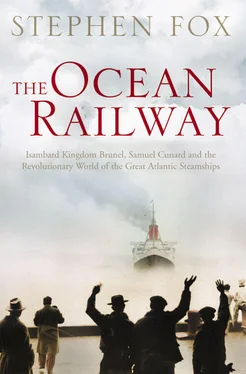1 ...8 9 10 12 13 14 ...38 This mystery turns on hard questions about Fulton’s character. Could he have made a clandestine trip to Scotland, borrowed from Symington’s work, and later hidden the entire episode? His subsequent history of lies and deceit suggests that he might have. In 1806, for example, he claimed in writing that he had held an American steamboat patent for fourteen years, and that some $280,000 had been subscribed to build twenty of his vessels for service on the Mississippi River – none of which was even remotely true. Later, when embroiled in patent controversies, he forged a ‘copy’ of a drawing he had supposedly made in June 1802 of a Hudson River steamboat with paddle wheels, at a time when he was actually still committed to an endless chain for propulsion. He also forged a letter, which he dated to 1793, about his supposed interest in paddle wheels at that time. In 1815, shortly before his death, he was caught committing perjury with this letter. All these manipulations were intentional, self-serving lies on Fulton’s part.
Symington’s later recollections, by contrast, erred in some details, but the essence of his account of the Charlotte Dundas is verifiably true. His version of the Fulton story was also corroborated by Symington’s engine man, Robert Weir. In 1824, after the matter had become controversial, Weir signed a sworn affidavit that he had fired up the boiler of the Charlotte Dundas on the occasion of Fulton’s visit and had heard Fulton identify himself by name and nationality. After their brisk eight-mile demonstration, according to Weir, Symington had lamented the difficulty of running his steamboat through the narrow Forth and Clyde Canal, and Fulton had replied that the broad rivers of America would present no such problem. The details and certainty of Weir’s affidavit seem authentic.
Fulton’s own explanation of how he converted to paddle wheels, later given under duress, must be weighed carefully. In 1811 he asked Joel Barlow to endorse his version of certain events for a potential patent lawsuit. ‘ I want yourdeposition as follows,’ he instructed: that in the autumn of 1802, while living at Barlow’s home in Paris, he had conducted experiments with various propelling devices, which by Christmastime had convinced him to adopt paddle wheels. ‘You will have this copied on foolscap,’ Fulton told Barlow, ‘and sware to it.’ Barlow apparently complied. It was at about this time that Fulton also forged other documents to bolster his claims of steamboat originality.
The smoking gun in this mystery is the vessels that Symington and Fulton actually produced. In January 1803 Fulton drew up the plans for his first steamboat. Overtly she did not much resemble the Charlotte Dundas. long and lean instead of short and stubby, with a different arrangement of the machinery and a distinct means of converting the engine’s reciprocating action to rotary motion. But in four crucial respects the boats may be linked. In both cases the engine’s cylinder was put in the exact centre of the hull, with the boiler behind it. Like the Charlotte Dundas, and unlike the vessel recently proposed in his agreement with Livingston, Fulton’s first steamboat was a towboat, with room on board just for the machinery, fuel and crew. Both vessels were propelled by paddle wheels: Symington’s by a single wheel at the stern, Fulton’s by two wheels attached to the sides. And – the most telling detail – Fulton’s paddle wheels were placed quite high in the boat, as in the Charlotte Dundas, so that only three paddles were under water at once, avoiding the wasted up-and-down motions of a more deeply immersed wheel.
It seems more than probable that Fulton did see the Charlotte Dundas and borrow from her design without ever acknowledging the debt. His first steamboat, built to the plans of January 1803, underwent a successful trial on the Seine later that year. Fulton eventually returned to the United States and, with Livingston’s support and a Boulton and Watt engine imported from England, made the paddle wheel steamboat later known to history as the Clermont.Her machinery and paddles closely resembled those of Fulton’s first steamboat of 1803 – and therefore may also be linked to the Charlotte Dundas. With the Clermont and her successors, Fulton ran a profitable steamboat service between Albany and New York City, marking the first sustained commercial use of steam navigation. The unfortunate Symington faded into obscurity and died penniless in 1831.
From this point on, geography largely determined the separate development of steamboats in America and Great Britain. In the United States, with its vast internal networks of inland lakes and long, broad, navigable rivers, steam navigation typically took the form of riverboats: large, fragile craft of shallow draught, driven at top speed by high-pressure boilers prone to explosion and disaster. In Britain, the characteristic steamboats were smaller and slower but safer, with low-pressure boilers, and sturdy hulls and high bulwarks designed to survive the heavier seas of coastal and ocean traffic. The future of Atlantic Ocean steamships would unfold mostly in the British Isles.
William Symington’s many frustrations had an apparent chilling effect on steamboat building in Great Britain. After he finally laid up his unwanted creation at Bainsford, nine years passed before another British steamboat was launched. The Comet, completed in the summer of 1812, became the first passenger steamer in Europe. Her planner and owner, Henry Bell, had been interested in steam navigation for over two decades. But his mercurial nature – his ‘ restless volatilegenius’, as a friendly biographer put it, ‘flying from one daring scheme to another’ – kept Bell pushing on to the next experiment before finishing his last one. It took him a long time to settle down and produce his first actual steamboat.
Like Watt and Symington, Bell was a Scotsman, born in 1767 near Linlithgow, west of Edinburgh. He came from a family of millwrights and was trained as a mason, millwright and shipbuilder, with early stints in Glasgow and London. (‘ I was nota self-taught engineer, as some of my friends have supposed,’ he later insisted.) Settled in Glasgow, he built houses and public works and started to focus intermittently on steamboats around 1800, after Watt’s patent expired. Bell tried to interest various patrons and governments but got no favourable responses. He hung around the Carron Works when the engine and machinery of the Charlotte Dundas were being constructed, to the point even of making himself a nuisance to the workmen. Later he repeatedly inspected Symington’s boat at Bainsford.
When Bell became the owner of the Baths Hotel in the resort town of Helensburgh, on the Clydesome twenty miles west of Glasgow, he acquired the necessary practical goad that pushed him finally to build a steamboat – for bringing Glaswegian customers out to his hotel. The Clyde, as yet undredged, was then a winding, shallow stream, often filled with sandbanks. Sailing boats drawing only five feet still might be grounded for an hour or two; passengers would be obliged to run on deck from side to side, rocking the hull and loosening the keel from the sand. To reach Glasgow, at the river’s eastern and narrowest point, Bell’s steamboat for the Clyde had to be small.
In the autumn of 1811 he contracted with John Wood, a shipbuilder in Port Glasgow, for a hull forty-two and a half feet long, eleven and a half feet wide, and five and a half feet deep, and a total capacity of only twenty-five tons. John Robertson of Glasgow, a builder of textile-mill machinery, made the engine: a cylinder eleven inches in diameter, stroke of sixteen inches, and four horsepower. Four small paddle wheels hung on the boat’s sides. Her smokestack at the bow doubled as the mast for a single square sail (as on an old Viking ship). The Cometwas named not to suggest her speed but in tribute to Halley’s Comet, recently visible in the night sky. Launched in July 1812, she began her Glasgow to Helensburgh to Greenock service a month later. As she puffed along the river, local boyswould run down to the water’s edge, expecting or hoping to see her blow up. She made the trip three times a week in each direction, covering the twenty-six miles to Greenock reliably in four hours, sometimes under three and a half – as fast as horse-drawn travel by land, and cheaper and much more comfortable than heavy, unsprung vehicles on bad roads. Within a year, four road coachesthat had been taking passengers to Greenock stopped running for lack of business.
Читать дальше












